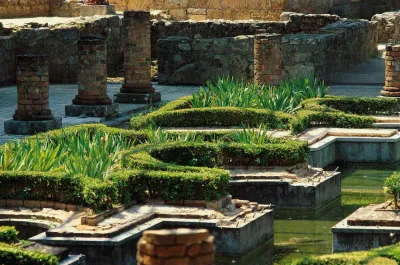
Casa de Cantaber 
Conimbriga mosaic Carole Raddato CC BY-SA
Conimbriga Roman baths Elisardojm CC BY-SARuínas de Conímbriga
The Roman settlement of Conímbriga was one of the largest in Portugal and is today the best preserved and most impressive. The ruins of this ancient town are situated in the countryside around 16 km (10 miles) south of Coimbra, in central Portugal.
Conímbriga as a settlement dates back to before the arrival of the Romans in Portugal. Originally it was occupied by the Celts (briga meaning defended area in Celtic) but what you see today is the work of the Romans who arrived here in the 2nd century BC, during the reign of Emperor Augustus.
Well positioned on the main trade route between Lisbon (Olisipo) and Braga (Bracara Augusta) the town flourished into a prosperous city. It is estimated that in its heyday during the 1st century AD the population of Conímbriga was around 10 thousand people. As the city grew so did the number of buildings we associate with the Romans; thermal baths, a forum, an aqueduct and a temple. All of these still exist to some extent, with many exquisitely preserved features. Perhaps most impressive amongst the ruins though are the remains of four once luxurious houses.
Of these villas it is the Casa dos Repuxos (House of Fountains) and Casa de Cantaber which are the highlights. The former is home to what are probably the finest mosaics in the ruins - scenes depicting hunting and the four seasons are set around a small central garden replete with decorative fountains. The Casa de Cantaber is one of the largest houses to be found in the Western outposts of the Roman Empire. A once opulent villa it centred around an ornamental garden set in a colonnaded courtyard. Beyond this you can see the exposed workings of the complex central heating system.
The site is also home to an informative museum which we'd recommend visiting before the ruins. This will help you make sense of what you see with reconstructions and illustrations of how the town would have looked. In addition there are many exhibits that have been unearthed during the ongoing excavations. These include coins, jewellery, more mosaics and sculptures.
Address
Condeixa-a-VelhaCoimbra3150-220Phone
+351 239 941 177Attraction type

Coimbra travel guide »
In terms of historic significance and romantic beauty, Coimbra is second only to Lisbon and Oporto. Its ancient buildings cling to the side of the hill that rises above the curves of the river Mondego, the ornate buildings of the famous University of Coimbra are its crowning glory. Indeed the university is still the lifeblood of the city and the change in atmosphere is notable when the…